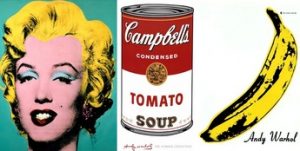Screen printing has been around for over 100 years. Screen printing, silkscreen, or serigraphy – from sericum, Latin for silk, is a twentieth century intaglio printmaking technique derived from traditional stencilling, itself one of the earliest forms of graphic art duplication.
Usually, screen printing involves placing a fine mesh screen, which is stretched tightly over a wooden frame, above a piece of paper. Then colour is forced through the screen with a rubber blade called a squeegee. Usually the screen is made of silk, hence the name silk screen printing. However, as cotton, nylon or metal can also be used, the more inclusive term is screen printing. Some professional artists prefer to use the term serigraphy to differentiate between artistic screen printing and that of commercial printing.
But, is it still relevant today?
Yes!
1.Limited edition look and feel
I have two giant posters up in my apartment that were screen printed in France. They are stunning! Whenever I have guests, they walk straight up to these giant framed posters, and just can’t get over the detail and that there is so much to look at. There are only a limited amount of posters that were available. You can see that just from the print. Digital printing looks super modern and flashy, but you can clearly see if it was effortless and should there be an order for a million prints. You just press print and bob’s your uncle.
2.Screen printing is an art
3.Flexible In Terms of Print Material
You can print on almost any surface! (As long as it’s flat) Including plastic, fabric, metal and wood to name just a few meaning the design you create could be turned into signs, t-shirts, office stationery and much much more! Screen printing is also really flexible when it comes to product shape making the process even more hassle free if you are looking to print designs onto slightly more obscure shaped products.
4. Perfect for Simple Design
If you are looking to print a simple design or text then screen printing is the ideal method to choose. Generally speaking, screen printing is best for artwork that has solid colour and isn’t photography based making it ideal for printing logos, company names or graphics. Gradients can also be achieved with screen printing and will leave you with a crisp, sharp design.
5. Ideal for High Print Volume
One of the beauties of screen printing is that the more products you have to print, the lower cost you will face. Despite having a complex set up process, screen printing usually only needs to be set up once so you can prepare you designs and go! This is great if you have a high volume of products to brand as your costs won’t increase which contrasts to other methods like digital printing which are often sold at a flat rate.
6.Durability
Screen printed designs are typically much more durable than the likes of heat press or digital designs which is due to the technique laying down thick layers of ink which are absorbed by the material, leading to enhanced durability, especially when a product will be under direct contact with sunlight, often causing them to fade which is a common characteristic of digital printing for example.
Now with all great things, there are the cons:

The first popularized Andy Warhol screen print was seen in 1962. It was his Marilyn Monroe’s
1.Requires High Print Volume
While screen printing is ideal for products in high volumes, it isn’t as cost effective if you have only a few items to print. The setup time is complex and involved so printing in low quantities won’t necessarily provide you with a cost effective result. Some printers will even limit the quantity they will print in so it’s worth checking this with your print provider first!
2.Set Up Time
As discussed, the set up for screen printing is much more complicated than the likes of digital or heat press printing, it also takes much longer so typically has a slightly slower turnaround time than other print methods. The common set up for screen printing involves imaging your design onto a fine-mesh screen which is then transferred onto the print material with ink. However for each colour/shape within your design a new screen is required.
3.Limited Colours
The process of screen printing doesn’t lend itself well if you are looking to achieve a design with a wide range of colours or a photography-based design. Spot colours can be mixed with a good degree of accuracy however, achieving specific gradients/shades is difficult.
Many print providers will offer a finite number of colours to choose from so it is worth asking your print provider for advice on your design and how it might be affected in terms of colour. Here at Evans Graphics for example, we have a team of experienced graphic designers who are on hand to help you with your design from start to finish.
We stock a range of screen printing vinyl.
Economy rolls are a 2-3 year. (Intercoat)
Electrostatic vinyl. 2-3 year. (Molco)
Promotional polyester films. 2 year.(Orafol)
Doming polyester. 2 year. (Orafol) Sheets & rolls
Intermediate vinyls – Polymeric film. 5-7 year. (Intercoat)
Ultra destructible cast vinyl. 10 year. (Orafol)
Contact us to find out more about pricing.
View the spec sheets here [click here]
[gravityform id=”1″ title=”true” description=”true”]


